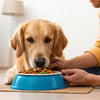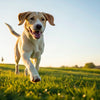Will Wet Dog Food Help My Dog Gain Weight? Understanding the Benefits and Considerations
- Houndsy
Table of Contents
- Introduction
- Understanding Wet Dog Food
- The Impact of Wet Dog Food on Weight Gain
- Mixing Wet and Dry Dog Food
- Case Studies
- Conclusion
- FAQs
Introduction
Did you know that approximately 56% of dogs in the United States are classified as overweight or obese? While many pet owners focus on weight loss and management for their chubby companions, there’s an equally important conversation to be had about dogs that are underweight and in need of gaining some healthy pounds. One common question that arises is: will wet dog food help my dog gain weight?
In this blog post, we will delve deep into the nutritional aspects of wet dog food, exploring its impact on weight gain. We’ll examine the benefits and potential downsides of incorporating wet food into your dog's diet, how it compares to dry food, and practical tips for ensuring your dog maintains a healthy weight. By the end of this post, you will have a well-rounded understanding of whether wet dog food is a suitable option for helping your furry friend gain weight—while also considering their overall health.
As we navigate through this topic, we invite you to reflect on your own pet feeding routines. Are you currently using wet food? Have you noticed any changes in your dog's appetite or weight? Let’s explore this together.
Understanding Wet Dog Food
Wet dog food, often sold in cans or pouches, is a popular choice among dog owners for various reasons. Unlike dry kibble, wet food typically contains a higher moisture content, making it more appealing and palatable for many dogs. The ingredients often include a combination of meat, vegetables, and broth, providing a flavorful meal that can entice even the pickiest eaters.
Nutritional Composition
The nutritional composition of wet dog food can vary significantly between brands and formulations. Here are some common components:
- Water: Wet dog food typically contains 70-80% water, which helps keep dogs hydrated.
- Protein: Many wet foods are rich in protein, essential for muscle maintenance and overall health.
- Fat: Wet foods often have varying fat percentages, impacting caloric density and palatability.
- Carbohydrates: Some wet foods include grains or fillers, which can influence weight gain if not balanced correctly.
Understanding these components is crucial, as they play a significant role in determining whether wet food can help your dog gain weight.
Does Wet Dog Food Cause Weight Gain?
The short answer is: it can, but it doesn't inherently do so. The potential for weight gain from wet dog food largely depends on several factors, including:
- Caloric Intake: If the total caloric intake exceeds your dog's daily energy expenditure, weight gain is likely, regardless of whether the food is wet or dry.
- Portion Control: Just like humans, dogs can overeat. If portions are not managed correctly, even low-calorie wet food can lead to weight gain.
- Palatability: Wet dog food is often more appetizing than dry kibble, which can lead to increased food intake. If you notice that your dog is eager to eat wet food, it might be tempting to give them more than the recommended portion, inadvertently causing weight gain.
The Impact of Wet Dog Food on Weight Gain
Benefits of Wet Dog Food
- Increased Palatability: Most dogs find wet food more appealing due to its aroma and texture. This can be especially beneficial for dogs that are picky eaters or those with reduced appetites.
- Enhanced Hydration: The high moisture content in wet food helps keep your dog hydrated, which is essential for overall health. Dehydration can lead to various health issues, and wet food can be a great way to boost water intake.
- Easier to Chew: For puppies, senior dogs, or those with dental issues, wet food can be much easier to chew and digest. This can be particularly beneficial for dogs recovering from surgery or suffering from oral pain.
- Nutritional Value: Many wet foods are formulated with high-quality ingredients, providing a well-rounded source of nutrition. Dogs that are reluctant to eat dry kibble may be more inclined to consume a nutritionally balanced diet when wet food is added.
- Increased Caloric Density: Some wet foods are specifically designed to be calorically dense, making it easier for dogs to gain weight without needing to eat large quantities.
Potential Downsides of Wet Dog Food
- Cost: Wet food is generally more expensive than dry kibble. If budget constraints are a concern, it may be necessary to balance feeding wet food with high-quality dry food to maintain a nutritious diet without overspending.
- Shorter Shelf Life: Once opened, wet food has a shorter shelf life and can spoil quickly if left out for long periods. Proper storage is essential to ensure the food remains fresh and safe for your dog.
- Dental Health Considerations: While wet food can be easier to chew, it may not provide the same dental benefits as dry kibble, which can help scrape plaque and tartar off teeth. Regular dental care, including teeth brushing and dental chews, is essential if your dog primarily eats wet food.
Mixing Wet and Dry Dog Food
Many pet owners choose to mix wet and dry dog food to take advantage of the benefits of both types. This approach can provide a balanced diet that accommodates your dog’s preferences while also ensuring they receive adequate nutrition.
Benefits of Mixing
- Balanced Nutrition: Mixing wet and dry food can help ensure that your dog receives a well-rounded diet that includes the benefits of both types.
- Cost-Effective: By combining wet and dry food, you can lower the overall cost of your dog’s food while still providing some of the flavor and health benefits of wet food.
- Portion Control: The Houndsy Kibble Dispenser is an excellent tool for precise portion control, ensuring that your dog receives the right amount of food—no more guessing!
How to Mix Wet and Dry Food
If you're considering mixing wet and dry food for your dog, here are some tips:
- Start Gradually: Transitioning from dry to wet food should be done gradually to avoid gastrointestinal upset. Start by mixing a small amount of wet food with their regular dry food, gradually increasing the wet food portion over several days.
- Monitor Portions: Be mindful of the total caloric intake. Mixing can lead to overfeeding if portions are not managed correctly.
- Observe Your Dog: Pay attention to your dog's reaction to the mixed food. If they seem to enjoy it and are gaining weight at a healthy rate, you may have found a winning combination!
Case Studies
Case Study 1: A Picky Eater
Meet Bella, a 5-year-old beagle who has always been a picky eater. Her owner noticed that she was losing weight and exhibiting low energy. After consulting with her veterinarian, Bella’s owner began incorporating wet food into her diet alongside her regular dry food. Within weeks, Bella not only gained weight, but her energy levels improved significantly.
Case Study 2: Senior Dog with Dental Issues
Rex, a 10-year-old Labrador suffering from dental problems, struggled with dry kibble. His owner transitioned him to a wet food diet, which made eating easier and more enjoyable for him. As a result, Rex maintained a healthy weight, and his overall quality of life improved.
Conclusion
In summary, wet dog food can be a beneficial addition to your dog's diet, especially when balanced with dry food. It does not inherently cause weight gain; rather, it depends on the overall diet, caloric intake, and individual dog factors. By understanding the nutritional composition of wet food and making informed choices about your pet’s diet, you can promote a healthy weight and overall well-being for your furry friend.
If you’re looking to elevate your dog’s feeding experience while ensuring proper portion control, we invite you to explore the Houndsy Kibble Dispenser. By making the feeding process easier and more enjoyable, we can help you and your pup create a healthier daily routine.
FAQs
- Can I feed my dog only wet food? Yes, dogs can thrive on a wet food diet as long as it is nutritionally balanced and contains high-quality ingredients.
- Will wet food make my dog’s teeth worse? Wet food alone may not provide the same dental benefits as dry food. However, with proper dental care, it can be a safe and healthy option.
- How can I prevent weight gain from wet food? Monitor portion sizes and ensure that total caloric intake does not exceed your dog’s energy needs. Mixing wet and dry food can also help maintain a balanced diet.
- Is wet food more expensive than dry food? Yes, wet food is generally more costly than dry kibble. Balancing both options can help manage costs while providing nutrition.
- How should I transition my dog to wet food? Gradually mix wet food into your dog's regular diet over a week to avoid digestive issues. Start with a small amount and increase it slowly.












